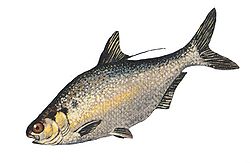- American gizzard shad
-
American gizzard shad 
American gizzard shad Scientific classification Kingdom: Animalia Phylum: Chordata Class: Actinopterygii Order: Clupeiformes Family: Clupeidae Subfamily: Dorosomatinae Genus: Dorosoma Species: S. cepedianum Binomial name Dorosoma cepedianum
(Lesueur, 1818)The American gizzard shad, Dorosoma cepedianum, is a fish of the herring family Clupeidae native to fresh and salt waters of eastern North America.
Like other gizzard shads, the body is deep somewhat forward of the middle. It is a grayish or silvery blue above, becoming silver on the sides and white below. The dorsal fin has 10-12 rays; in adults, the last ray is very long, extending beyond the rest of the fin. The caudal fin is deeply forked. They can reach a length of 22.5 inches (57 cm), and weigh up to 4.37 lbs (1980 grams).
American gizzard shad begin life feeding on zooplankton, using their teeth to catch them. At about 1 inch in length, they lose the teeth, become deeper-bodied, develop the muscular gizzard, and become filter feeders, consuming both small invertebrates and phytoplankton, as well as some sand for the gizzard.
They live in a variety of open waters, both clear and silty, including rivers, swamps, lakes, and bays, typically near the surface. They avoid fast-moving water.
Native range extends from the Great Lakes and St. Lawrence River area west to eastern South Dakota and central New Mexico, as well as to the Gulf of Mexico, where it has been found as far south as Rio Panuco in Mexico.
The specific epithet cepedianum honors French naturalist Bernard Germain de Lacépède (1756-1825).
Forage Fish Controversy
Gizzard shad are a preferred food of the largemouth bass, an economically important sport fish, and they reproduce rapidly. For this reason, it is widely believed that bass fishing is best where gizzard shad are abundant. Indeed, the smaller threadfin shad is a key player in Southern lakes that produce "trophy" bass. However, the practice of introducing gizzard shad to improve bass fishing is controversial.
Gizzard shad do provide large bass with a steady supply of quality food. They grow faster than bluegill and are easier for bass to swallow, so large bass (approx. five pounds or larger) benefit from shad introduction. Also, by providing bass with alternate prey, they reduce predatory pressure on young bluegill.
However, in public lakes with heavy fishing pressure, gizzard shad are of questionable value. They grow quickly and can easily grow too large for most bass to swallow, so their value as a forage fish is limited. They also compete with hatchling bass for food, reducing their survival rate and preventing many from growing to "replace" the legal-size bass kept by fishermen. If sufficient food is available (e.g., a healthy bluegill population), bass do not grow any faster in the presence of shad.
Although bluegill enjoy reduced predatory pressure in the presence of gizzard shad, their young also compete with shad for food. As a result, they grow more slowly; it takes four years for a hatchling bluegill to reach six inches in length when gizzard shad are present, compared with three years in the absence of shad.
Gizzard shad contribute to eutrophication, both by fertilizing algae with their copious feces and by preying on "grazing" zooplankton that normally feed on algae.
In spite of the possible benefits to trophy-size bass, gizzard shad generally have a negative effect on sport fish. Most wildlife management agencies try to prevent their spread. Using them as live bait is illegal in most public lakes, and deliberately introducing any fish into a public body of water is illegal as well.
References
- William F. Sigler and John W. Sigler, Fishes of Utah (University of Utah Press, 1996), pp. 59–62
- Froese, Rainer, and Daniel Pauly, eds. (2006). "Dorosoma cepedianum" in FishBase. October 2006 version.
- Doug Keller, "The Truth about Shad." Outdoor Indiana, May/June 2006, pp. 37–39.
- "Stocking Gizzard Shad for Trophy Bass," Kedric Nutt. Retrieved 3/14/2008.
Categories:
Wikimedia Foundation. 2010.
